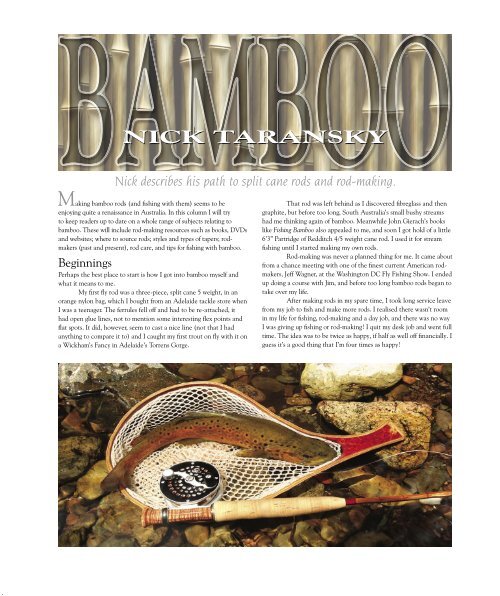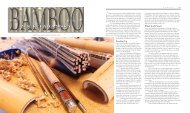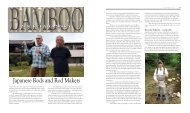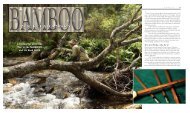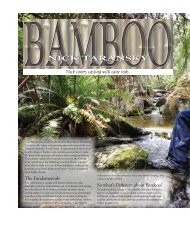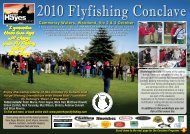Create successful ePaper yourself
Turn your PDF publications into a flip-book with our unique Google optimized e-Paper software.
B A M B O O 111<br />
Why <strong>Bamboo</strong><br />
This question probably has several answers ranging from the practical<br />
to the metaphysical. Most important to me is how well bamboo fishes<br />
in stream situations. At a technical level, the weight and natural flex<br />
in bamboo provides an inherent amount of rod loading, even with no<br />
line at all through the guides. This means that with little effort, and<br />
just the leader or a couple of feet of line out, the rod will ‘work’ and<br />
deliver a very accurate, delicate, short cast. In stream situations, this<br />
is where a lot of fish are caught.<br />
As the length of cast increases, the line contributes to<br />
the rod loading. <strong>Bamboo</strong> retains its ‘sweet spot’ as the cast length<br />
increases from short to middle distance, the stiffness in the power<br />
fibres resisting the weight and natural flex of the material. At longer<br />
range, bamboo can still perform remarkably well, particularly if<br />
allowed to do the work without overpowering the casting stroke. The<br />
smooth, deep flex in bamboo also helps it to protect tippets on the<br />
strike, and during the playing of fish.<br />
Tonkin Cane (used to make most bamboo rods) has great<br />
aesthetic appeal, with heat treating or flaming bringing out rich golds<br />
and browns, with blonde rods retaining a lemon straw colour. I still<br />
get the same excited feeling when the first coat of varnish goes on<br />
each new rod, revealing the intense colour and natural pattern of the<br />
power fibres in each strip, with splashes of contrasting yellow at the<br />
nodes.<br />
The People<br />
One of the other great things about getting into bamboo is connecting<br />
with people. When I hold a rod I’ve made, I think of its origins. There<br />
are the unknown Chinese women and men who grow and harvest<br />
the bamboo in the Kwantung province. Andy Royer, from ‘The<br />
<strong>Bamboo</strong> Broker’ in Seattle, who gets it around the world to me. Bailey<br />
Wood, who with his stepson Steve at Classic Sporting Enterprises in<br />
Vermont, make the industry-standard nickel silver ferrules and other<br />
rod-making components. I love that Bailey is too busy working to set<br />
up an internet account, so I usually phone him to place an order. This<br />
can result in a conversation which at my end focuses on drought and<br />
forty degree heat, while at the other end the problems are streams<br />
freezing solid, two metres of snow, and cutting up moose road-kill into<br />
steaks.<br />
Then there’s Mike and Susan McCoy, who fashion exquisite<br />
agate insert stripping guides in Washington, and of course, Jeff<br />
Wagner, who got me started on the rod-making craft and provided<br />
me with the best tools and other components. I musn’t overlook<br />
Bob Corsetti, who along with a few hardcore fishing mates in New<br />
Hampshire, bench-make fine Peerless fly reels one at a time. And of<br />
course Terenzio Zandri or Mike and Susan Winter, whose handcrafted<br />
lines often complete the picture at the mug’s end of the rod.<br />
All these people fish too, and make a living from<br />
craftsmanship and the quest for quality. How they all contribute to a<br />
bamboo rod, makes for a nice kind of globalisation. There’s something<br />
downright exotic about a rod which can claim such an international<br />
mix of materials and workmanship: bamboo - China, cork - Portugal,<br />
nickel silver hardware - USA, wrapping silk - Japan, agate - Brazil,<br />
burl spacer (and labour!) - Australia. Put on an English Hardy reel,<br />
loaded with a French or Italian silk line, and you just about have the<br />
UN of flyfishing.<br />
Rod-makers and Rod-making<br />
Meeting other rod-makers and enthusiasts is rewarding too. The<br />
annual Victorian Fly-Fisher’s Association Cane Day has been running<br />
for several years now, and the Inaugural NSW Rod-makers Gathering<br />
was held at Bowral in September 2008, thanks to Callum Ross.<br />
Every time you think you know everyone else who is making<br />
rods, another person pops up with a handful of wonderful rods they’ve<br />
been making in their garage. It’s a joy to see and cast another’s efforts,<br />
and to share ideas and information.<br />
While there is quite a bit of work in making a rod—normally<br />
around 50 to 60 hours (and probably at least twice that for your first<br />
one)—it is very much a one-step-at-a-time process, and anyone<br />
thinking about trying it shouldn’t be scared of giving it a go. One<br />
nice thing about making your own rods is how you can play around<br />
with designs and tapers. By and large, the classic tapers have become<br />
just that for a reason. Master rod-makers have developed them<br />
after many years of trial and error, scientific design, and—most<br />
importantly—fishing. It is interesting though, to modify these tapers<br />
or come up with your own, particularly when considering Australian<br />
conditions. Though our waters obviously share common features with<br />
streams around the world, I like to think Australian fishing has its
112 F L Y F I S H E R<br />
own character. In my adopted home region, the Snowy Mountains/<br />
Monaro, the waters are generally small, maybe like parts of the<br />
American East, but our high plains often mean high winds, more like<br />
the American West. A lot of streams are overgrown with bankside<br />
vegetation, in stark contrast with manicured chalkstreams in Europe.<br />
These factors, along with individual casting styles, leave plenty of<br />
scope for trying different bamboo tapers.<br />
Having the input of people like my fishing mentor and long<br />
time Snowy Mountains guide, Paul Bourne, and master caster Peter<br />
Hayes, is invaluable to my rod-making. Paul is the most passionate,<br />
hardcore, knowledgeable stream fisherman I have met, having fished<br />
widely in Tasmania and New Zealand, as well as the Snowy Monaro<br />
area. Haysie’s casting and teaching ability is exceptional, and the<br />
continual expansion of his own understanding of casting styles gives<br />
plenty of food for thought about what makes a good casting rod.<br />
The History<br />
<strong>Bamboo</strong> and its connection to angling history and tradition, appeals<br />
to a lot of people. These days, when the latest computers and mobile<br />
phone models become obsolete around the time you learn how to<br />
use them, it’s comforting to have a rod that is based on a design and<br />
taper close to a hundred years old. For me, I don’t necessarily think<br />
things are good BECAUSE they’re old or old style, but old stuff that’s<br />
still around tends to be good or it wouldn’t have lasted (I’m probably<br />
quoting or paraphrasing Gierach there).<br />
I love making rods from new tapers (or more likely old tapers<br />
that I haven’t tried yet), but for my own fishing, I would be happy just<br />
to use the first cane rod I made when learning from Jeff Wagner. The<br />
taper is a 7 foot, 4/5 weight that Jeff tweaked a bit from a classic Paul<br />
Young Driggs River Special. Smooth in close, it loads into the butt<br />
(the hand, actually) and has the kick to drive a Paul Bourne Hopper<br />
into a gale under a tight undercut bank. Having a rod you’ve fished<br />
with a lot is similar to having an old pair of sandshoes which still have<br />
plenty of life left in them—though your partner may not think so.<br />
Over time, the shoes have moulded to fit your feet, and you barely<br />
notice you’re wearing them. You’re also pretty sure nothing else will<br />
probably ever fit quite as well.<br />
<strong>Bamboo</strong> rod maker Nick <strong>Taransky</strong> lives in Queanbeyan, near the streams of the Monaro and Snowy Mountains.<br />
Visit www.taranskybamboo.com.au


